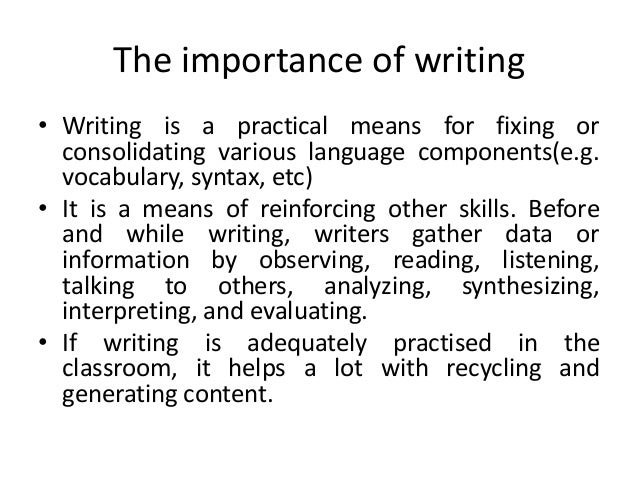Estrategias didácticas para mejorar el Writing (Didactic strategies to improve Writing).
Importance of writing in the classroom
1. Writing improves communication skills.
First and foremost, writing provides a vehicle for expression and communication. No matter the age or grade level of your students, diligent writing practice will boost both their skill and comfort level with revealing and relating their own thoughts and feelings.
2. Writing helps students review and remember recently learned material.
Isn't it always easier to remember a household task or a website to visit later if we write it down somewhere? A brief writing assignment at the end of class, focusing on the day's lesson and discussions, is a great way to reinforce the material, support long-term recall of the key lesson points and help build writing skills all at the same time.
3. Writing helps educators assess student learning.
Probably the most common use of writing in the contemporary classroom is for a given student to demonstrate that he or she knows and understands x or y concept. Whether the assignment is, for example, an intensive compare-and-contrast essay at the secondary level or writing and illustrating a haiku in the primary grades, writing assignments help teachers see what material students have mastered and where there may be gaps.
4. Writing encourages creativity and exploration.
Daily writing encourages a creative flow that can help students use their imaginations, explore possibilities, delve into problem solving, and engage in storytelling. In addition to "serious" writing assignments which are reviewed and graded, it is important to assign "free" or "creative" writing time, so that students can explore vocabulary, concepts, and writing styles that they wouldn't risk in a formal essay or heavily graded assignment.
5. Writing is essential for self-understanding.
Even a cursory search online will reveal a plethora of diary-like blogs, filled with entry after entry of highly personal content. In the same way that these blogs serve their authors, classroom writing can help students understand and make sense of their own experiences, locate contexts, and make (sometimes surprising) discoveries about their own thoughts and feelings.
Classroom teachers will find that reading through their students' writing assignments can give them great insight into each student's personality, style, and comprehension level of the material being presented. When a high value is placed on consistent writing in the classroom, it's a win-win all around.
Estrategias para el Aprendizaje del ingles
- Clasificación y verificación: este tipo de estrategias son utilizadas para confirmar la comprensión de la lengua.
- Predicción, inferencia inductiva: El estudiante hace uso de su lengua materna para inferir significado, por lo tanto hace uso de conocimientos previos tanto lingüísticos como conceptuales en la lengua.
- Razonamiento Deductivo: en este tipo de estrategias el estudiante usa un patrón general para resolver su problema de aprendizaje, en esto caso hace uso de analogías, síntesis.
- Práctica: en esta el punto principal en el estudiante es la exactitud en la lengua, a través de ensayo, error ,repetición, imitación.
- Memorización: en este tipo de estrategia de aprendizaje lo principal en el estudiante es retener la información.
- Monitoreo: esta ocurre cuando el estudiante mismo es capaz de dar seguimiento e identificar las partes fuerte y débiles en su aprendizaje.
- Contextualización: aquí el alumno busca por sí mismo dar sentido a la frase que quiere aprender en secuencia.
- Toma de nota: con este tipo de estrategia el estudiante busca llevar a cabo un control de las ideas principales o informaciones que el /ella considera necesario para aprender.
Suscribirse a:
Comentarios (Atom)
-
1. Writing improves communication skills. First and foremost, writing provides a vehicle for expression and communication. No matter ...

